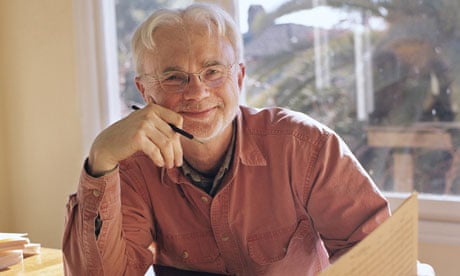It's not even called a symphony, I hear you cry! Well, maybe, but John Adams's Harmonielehre is, as I will now attempt to argue, one of the most significant and sophisticated commentaries on and embodiments of symphonic thinking of the late 20th century. For a start, it's cast in three large movements, it includes references and reimaginations of Mahler, Sibelius, and Wagner, and for all its diversity of soundworld and musical material, it creates a single musical and dramatic arc in its 40 minutes that is definitively symphonic. And just because something isn't called a "symphony" doesn't mean it isn't one!
Adams's title comes from Schoenberg's great harmony textbook, an essential musical tome that gives you the keys not to a theory of composition-with-12-tones (Schoenberg's serialism in other words), but to tonal harmonic practice from Palestrina to Bruckner. In a way, it's a book that's proof positive of one of Schoenberg's maxims, that there's still a lot of great music to be written in C major. Adams's piece is an attempt to do just that (well, in E minor and E flat major…), yet as well as its passages that are clear love-songs to symphonic and Wagnerian late-romanticism, his Harmonielehre ("Harmony Lesson", composed in 1985 when Adams was in his late 30s), is full of surreal dreams and post-minimalist rhythms, glitter, and energy.
It opens with a battering ram of E minor chords. Actually, that's not quite the right image: the 39-fold repetitions of E minor at the start of Harmonielehre were inspired by a dream Adams had of a huge tanker in San Francisco Bay. Watching this sea-borne behemoth, Adams dreamt that it suddenly took off "like a rocket ship with an enormous force of levitation". The next morning, Adams conceived the opening of the piece, the explosive propellant for his own symphonic rocket, which was a commission from the San Francisco Symphony for a large-scale work. Until the dream, Adams was in the throes of writer's block, a scarring experience that the slow second movement, The Anfortas Wound, commemorates and transcends: Adams makes clear references to the emotionally bleak opening of Sibelius's 4th Symphony at the start of the movement, and its climax is a rewriting of the terrifying chord that screams out in pain in the Adagio of Mahler's 10th Symphony.
There are two other catalysts for the composition of Harmonielehre. There was another dream, of Adams's infant daughter careering round the cosmos on the back of a flying medieval theologian, Meister Eckhardt, which inspired the ethereal music that opens the third movement. The other was the epiphany of Adams's relationship with late romanticism, and especially Wagner. In the context of the West Coast of America in the late 1970s and early 80s, Wagner was as uncool as it got. Adams's reputation as a young composer was founded on the way he had taken the example of Steve Reich and Philip Glass's as the inspiration for his own resuscitation of tonality, most notably in Shaker Loops and the ecstatic choral writing of Harmonium. But the prospect of a properly symphonic canvas to work on presented a new challenge: for Adams, it was never enough simply to "repeat the theme/Repeat and repeat again, as the pace mounts", as William Carlos Williams's text puts it in Steve Reich's The Desert Music. What Adams wanted in his music was some of what he heard in Wagner's Götterdämmerung: "The harmonies, restless and forever migrating to a new tonal center, moved between tension and resolution in an uncanny way that constantly propelled the listener forward … This was not just music about desire. It was desire itself. The emotional and sensual power it possessed was inescapable."
Achieving that in Harmonielehre meant, for Adams, aping the style and manners of late romantic music, and not just through quasi-quotations. Listen to music like the achingly expressive lyrical theme at the centre of the first movement, which apart from the post-minimalist filigree of some of its orchestral decoration, sounds like a theme culled from Mahler's or Zemlinsky's or the romantic Schoenberg's workshop, circa 1900. But the atmosphere of the music's relationship with these earlier traditions is never cool, detached, or distancing. As Adams himself says, "This is a work that looks to the past in what I suspect is a 'postmodernist' spirit, but … it does so entirely without irony." Adams wants Harmonielehre to be felt as genuinely emotional, genuinely affecting, genuinely symphonic. And through all the craft - the artifice, if you will - of his composition, I think he manages it: if you know your Sibelius and your Mahler, the slow movement will bring more than a twinge of recognition, but you don't need to know either to feel the music's expressive power.
It's the same at the end of the piece, in which Adams stages an epic battle between the work's main keys. As he says, "in a more traditionally worked-out piece, there would be a modulatory sequence that would present the outcome in a rather dialectical way. But in this case, I simply place the keys together, as if in a mixer, and let them battle it out. And finally E-flat wins through its strength, and this moment seems like an epiphany." Is Adams's epiphany of late 20th century symphonism yours too? You decide.
Four key recordings
Rattle's is the one for me, but see what you reckon!
City of Birmingham Symphony Orchestra/Simon Rattle
San Francisco Symphony/Edo de Waart
San Francisco Symphony/Michael Tilson Thomas

Comments (…)
Sign in or create your Guardian account to join the discussion